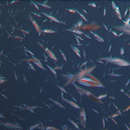fr
noms dans le fil d’Ariane


The photophores along the body and tentacles of the Watasenia scintillans are used to attract prey, provide camouflage, frighten predators, and to attract a mate. The firefly squid also has highly developed vision. Its eyes contain three different types of light-sensitive cells and are believed to be capable of distinguishing different colors.
Communication Channels: visual
Other Communication Modes: photic/bioluminescent
Perception Channels: visual
Watasenia scintillans is not protected under any conservation program.
US Federal List: no special status
CITES: no special status
State of Michigan List: no special status
Fertilized eggs hatch in 6-14 days depending on the water temperature, which varies from six to 16 degrees Celsius. Higher temperatures encourage quicker hatching.
At 15 degrees Celsius, one hour after fertilization, polar bodies appear, followed in five hours with first cleaveage. By 10 hours, 100 or more cells have been formed, and around 16 hours the embryonic lobe has been developed. The embryonic lobe covers about half of the egg in a day and a half. In four days, primordial eyes are present and oral depression starts. A day later, primordial arms, mantle, and funnel appear and then chromatophores appear on the mantle and the eyes are developed. Final organ and chromatophore formation and hatching occurs in 8-8.5 days.
Development - Life Cycle: metamorphosis
Eating raw Watasenia scintillans, known in Japan as Hotaruika, that is infected with spirurina type X larvae, belonging to the phylum Nematoda, can cause abdominal pain, nausea and vomiting, diarrhea, creeping eruption, and ileus (bowel obstruction).
Negative Impacts: injures humans (causes disease in humans )
Watasenia scintillans can be eaten raw, known as Hotaruika in Japan, or cooked. These species of squid also draw large crowds during their spawning season at Toyama Bay in Japan. The large schools that swim up to the shallow waters light up the dark water along the shore, giving tourists a nighttime show. This spectacle has led to the bay being named a Special Natural Monument and construction of a museum devoted to the species.
Positive Impacts: food ; ecotourism
Watasenia scintillans are prey for northern fur seals, Callorhinus ursinus and is a predator of shrimp, fish, and planktonic crustaceans. This squid is also a host to nematode larvae.
Commensal/Parasitic Species:
Watasenia scintillans consumes a diet consisting of shrimp, crabs, fish, and planktonic crustaceans. The photophores on the tips of its tentacles are used in a flashing pattern to attract prey, especially fish.
Animal Foods: fish; aquatic crustaceans; other marine invertebrates; zooplankton
Primary Diet: carnivore (Piscivore , Eats non-insect arthropods)
The geographic range of Watasenia scintillans is the Western Pacific ocean around Japan.
Biogeographic Regions: pacific ocean (Native )
Watasenia scintillans is a marine animal found in depths of 200 to 400 meters.
Range depth: 200 to 400 m.
Habitat Regions: temperate ; tropical ; saltwater or marine
The firefly squid lives for about one year.
Watasenia scintillans is a small cephalopod, growing to 7-8 cm. The firefly squid is equipped with special light producing organs called photophores. Photophores are found in many parts of the body but large ones are usually found on the tips of the tentacles as well as around the eyes. These lights can be flashed in unison or alternated in patterns. This squid has arms with hooks and tentacles with hooks and one series of suckers. The mouth cavity has dark pigmentation.
Average length: 7.62 cm.
Other Physical Features: ectothermic ; heterothermic ; bilateral symmetry
The photophores along the body of the squid can be used against predators in either a warning form or as counter-illumination camouflage. The northern fur seal, Callorhinus ursinus, is a known predator.
Known Predators:
Anti-predator Adaptations: aposematic ; cryptic
Bioluminescent photophores can attract mates and be used for communication with other squids.
The spawning season runs from March to May. During this time, firefly squids can be seen gathering in large numbers to lay their eggs. Once the eggs have been released into the water and fertilized, the adult squid die. This completes the one-year life cycle of the squid.
Breeding interval: Once yearly
Breeding season: March - May
Average age at sexual or reproductive maturity (female): 1 years.
Average age at sexual or reproductive maturity (male): 1 years.
Key Reproductive Features: seasonal breeding ; broadcast (group) spawning; oviparous
Adult firefly squids die after eggs have been released into the water and fertilized.
Parental Investment: no parental involvement